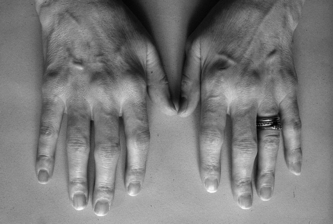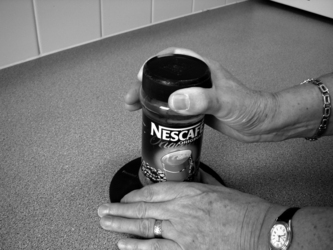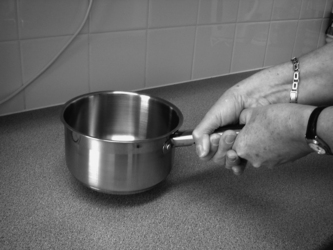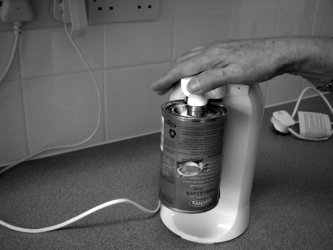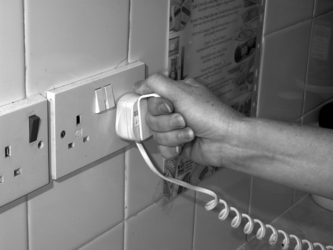Chapter 10 Joint protection and fatigue management
INTRODUCTION
Joint protection and fatigue management address the priority concerns of people with arthritis: pain, fatigue and hand and finger function (Heiburg & Kvien 2002, Hewlett et al 2005). Joint protection underlies all rehabilitation of people whose joints are at risk from arthritis (Cordery & Rocchi 1998), yet fatigue management is often inadequately addressed (Hewlett et al 2005). To be effective, both require people with arthritis changing habits and routines. Teaching facts can be done quickly but enabling long-term behavioural change requires greater input. This chapter discusses what joint protection and fatigue management strategies are, practical applications, evidence for effectiveness, how to help people change and outcome measures.
JOINT PROTECTION
Joint protection developed from understanding pathophysiology of joint diseases, joint biomechanics, forces applied during activity and how these contribute to the development of deformity (Brattstrom 1987, Chamberlain et al 1984, Cordery 1965, Cordery & Rocchi 1998, Melvin 1989). The aims of joint protection in inflammatory arthritis are to:
For people with osteoarthritis (OA) the aims are to:
Joint protection is an active coping strategy to improve daily tasks and role performance helping reduce frustration arising from difficulties with these, enhance perceptions of control and improve psychological status (Hammond et al 1999). Much of joint protection literature focuses on hand problems in rheumatoid arthritis (RA), so this is explored in detail in this chapter but strategies are similarly applicable in other conditions and for other joints.
PATHOPHYSIOLOGY OF HAND DEFORMITIES AND BIOMECHANICAL BASIS OF JOINT PROTECTION
Considering why deformities develop with RA helps in understanding how joint protection may contribute to preserving joint integrity. Deformities develop due to a combination of persistent synovitis disrupting joint structures and both normal and abnormal forces passing over joints (Adams et al 2005, Flatt 1995). In the longer-term, disruptions to bony architecture from erosions and osteophytes can further alter joint mechanics at any joint.
The metacarpophalangeal (MCP) joints
Persistent synovitis can weaken MCP collateral ligaments, volar plates and dorsal hoods leading to joint instability. The finger extensors can then slip volarly and ulnarly, increasingly acting as weak flexors. Normal MCP joint features contribute to ulnar deviation once joint structure is disrupted. These include: the flexor tendons approach the index and middle fingers from an ulnar direction exerting a significant ulnar torque; the metacarpal head anatomically predisposes to tendons slipping ulnarward; and the ulnar interossii exert a stronger pull than the radial (see Fig. 16.3 Ch 16).
The interphalangeal (IP) joints
Persistent synovitis can disrupt positioning of the extensor tendon central slip and lateral bands allowing Boutonniere deformity to develop. MCP joint inflammation can cause protective spasms in the interossii causing MCP flexion during finger extension (the intrinsic plus position), contributing to Boutonniere and swan-neck deformity development (see Fig. 16.4 Ch 16).
JOINT PROTECTION AND THE HANDS
Anatomical disruptions, combined with normal daily hand use patterns, can promote deformity. Power grip requires MCP ulnar deviation, especially in the 4th and 5th fingers. During lifting, external pressures in a volar or longitudinal direction increase strain on weakened wrist ligaments. Strong pinch grips increase intrinsic muscle pull promoting imbalance at the IP joints. Hand joint protection in RA thus focuses on changing movement patterns to limit: strong grips, twisting movements and sustained grips at the MCPs (reducing MCP ulnar forces); lifting heavy objects and sustained wrist radial positioning (reducing wrist volar and radial forces); and tight, prolonged key, tripod and pinch grips (reducing volar and ulnar forces on the MCP and IP joints).
In the early stages, many with RA are all too aware of hand function problems: dropping items, weaker grip, reduced dexterity and frustration from activities taking longer and being more painful. However, early signs of RA can be subtle (see Fig. 10.1). Whilst swelling may be noticeable, many do not notice a more prominent ulnar styloid, slight wrist radial deviation and 5th MCP ulnar deviation, early correctable finger deformities, nor gradual loss of movement. In early RA average losses are 20° wrist extension, 30° wrist flexion, 15° MCP flexion and only 40% of normal power and pinch grip strength (Hammond et al 2000). A third can develop hand deformities by two years (Eberhardt et al 1990). This suggests joint protection and hand exercises should be provided early and effectively to limit decline (Fig. 16.4 Ch 16).
JOINT PROTECTION PRINCIPLES
Principles taught are shown in Box 10.1 and in Chapter 16 (Box 16.4). Focus on priority messages in plain English. For example, for the hands:
BOX 10.1 Joint protection and energy conservation principles
Joint protection
 Reduce the force and effort required to perform activities by altering working methods, using assistive devices and reducing the weight of objects
Reduce the force and effort required to perform activities by altering working methods, using assistive devices and reducing the weight of objectsJoint protection principles are reviewed in Palmer and Simons (1991).
JOINT PROTECTION STRATEGIES
Joint protection is the application of ergonomics to everyday activities, work and leisure. Many people find ways of reducing pain and fatigue in daily activities through trial and error, but this takes time. Joint protection and energy conservation education should apply a systematic approach to changing habits, finding new solutions and speeding up change. Strategies include:
Altering working methods
E.g. altering movement patterns during tasks; more efficient positioning, e.g. sitting on a perch stool to iron; and reducing forces from lifting, pushing/pulling, stretching/reaching, carrying (Figs 10.2–10.5).
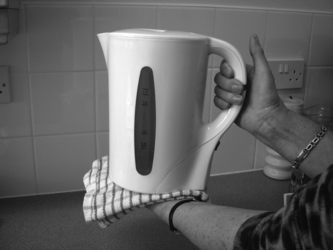
Figure 10.2 Carrying a kettle with two hands – distributing load, reducing metacarpophalangeal joint deviation.
Restructuring activities
E.g. reordering task sequences within these, eliminating unnecessary steps to increase efficiency.
Using assistive technology
Reducing effort required performing activities, e.g. jar openers, dycem matting, key turners, easy-grip scissors, walking aids (see Ch. 9, Fig. 9.3).
Selecting appropriate product designs (universal designs)
E.g. equipment with non-slip handles (e.g. irons, screwdrivers, Good Grip kitchen equipment); electric alternatives (e.g. can openers, see Fig. 10.6); lightweight models (e.g. hand held vacuum cleaners for stairs); labour saving equipment (e.g. tumble drier, plug pulls, see Fig. 10.7); lever taps. Further details on assistive technology and environmental adaptation can be found in Chapter 9.
FATIGUE MANAGEMENT
Fatigue increases pain, cognitive disturbance (e.g. reduced concentration) and psychological effects (e.g. increased stress, low mood). There are many possible causes (see Box 10.2) and multiple solutions are needed. Helping people identify potential causes helps them prioritise changes. Practical strategies include:
BOX 10.2 Examples of factors contributing to fatigue
Stay updated, free articles. Join our Telegram channel

Full access? Get Clinical Tree





